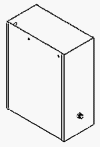No Pressure
Low Or No Autoclave Pressure
This chapter covers autoclave pressure and how to determine why your unit is not building or maintaining pressure. Pressure is created & controlled in the first two phases of the Sterilization Cycle:
 Fill Cycle
Fill Cycle
 Sterilize Cycle
Sterilize Cycle
In order to have autoclave pressure these processes must occur:
 The Right Amount Of Water has to be in the chamber.
The Right Amount Of Water has to be in the chamber.
 The water has to be converted to steam
The water has to be converted to steam
 Air has to be removed from chamber
Air has to be removed from chamber
 The Chamber has to be completely sealed
The Chamber has to be completely sealed
All of these components are required to build and maintain autoclave pressure. If any are faulty, then the pressure process will not occur
Visual Inspection
Remove the Cover On Your Autoclave & Start a Cycle Like You Normally Would
Visually inspect the system for leaks. Any leak, no matter how small will keep the unit from developing and maintaining the autoclave pressure at the required level for sterilization to be completed.
Autoclave Pressure And The Fill & Sterilization Cycles
During the start up phase of the Autoclave Sterilization Cycle, the following process occur:
 Water enters the Autoclave chamber and fills to a predetermined level
Water enters the Autoclave chamber and fills to a predetermined level
 The chamber is sealed & heated, turning the water into steam.
The chamber is sealed & heated, turning the water into steam.
 Air is evacuated from inside the chamber in the early stages of the sterilization process.
Air is evacuated from inside the chamber in the early stages of the sterilization process.
 Steam is the gaseous state of water and expands as it is heated - this creates the autoclave pressure
Steam is the gaseous state of water and expands as it is heated - this creates the autoclave pressure
 The heating elements turn off and on as needed to maintain the right temperature & pressure
The heating elements turn off and on as needed to maintain the right temperature & pressure
 At the end of the sterilization cycle, the heat is turned off and the water and steam are vented back into the reservoir.
At the end of the sterilization cycle, the heat is turned off and the water and steam are vented back into the reservoir.
Open the door to see if water is entering into the chamber and filling to it's recommended level (make sure the autoclave is level)
Autoclave Pressure & The Fill Cycle
If water is not entering the autoclave chamber, or if the water drips in slowly, examine the path the water takes to get into the chamber. If there is no (or not enough) water in the autoclave chamber, no autoclave pressure can be built up or maintained

 The water is contained in a reservoir - Make sure the reservoir is full (to it's max level mark)
The water is contained in a reservoir - Make sure the reservoir is full (to it's max level mark)
 In the fill cycle, the water flows through a tube into the main valve body
In the fill cycle, the water flows through a tube into the main valve body
 The Main Valve Body contains the Fill Valve which acts like a gate and is opened & closed by the Function Switch
The Main Valve Body contains the Fill Valve which acts like a gate and is opened & closed by the Function Switch
 In the Fill Cycle, the Function Switch opens the fill valve and allows water to pass through the main body and on to the inside of the autoclave chamber
In the Fill Cycle, the Function Switch opens the fill valve and allows water to pass through the main body and on to the inside of the autoclave chamber
Trace this route to determine where the water is stopping along its path between the reservoir and the chamber. Check for filters along the path and make sure they are allowing the water to pass through. Filters should be replaced on a regular basis.
Autoclave Pressure & Heat
If the right amount of water is entering the chamber, the next thing to look at for the loss of autoclave pressure is the heat. To build pressure, the water must be turned into its expanding, gaseous state (steam). The boiling point (212
There are no products to list in this category.
Categories
Important Links
- › For Missions Only
- › How To Repair Your Autoclave PC Control Board
- › OCM OCR Exploded View - UPDATED
- › Spore Test Failure
- › Sterilizer FAQ
- › Shipping Policy
- › Return/Cancellation Policy
- › Registered Trademarks
- › Disclaimer
- › Cleaning Statim Water Pump Filters
- › Payment Methods
- › International Customers
- › How To Test Autoclave Heating Elements
- › Testimonials
- › Can't Find The Door Gasket (Seal) You Need?
- › Used Autoclaves - What To Look For


















































